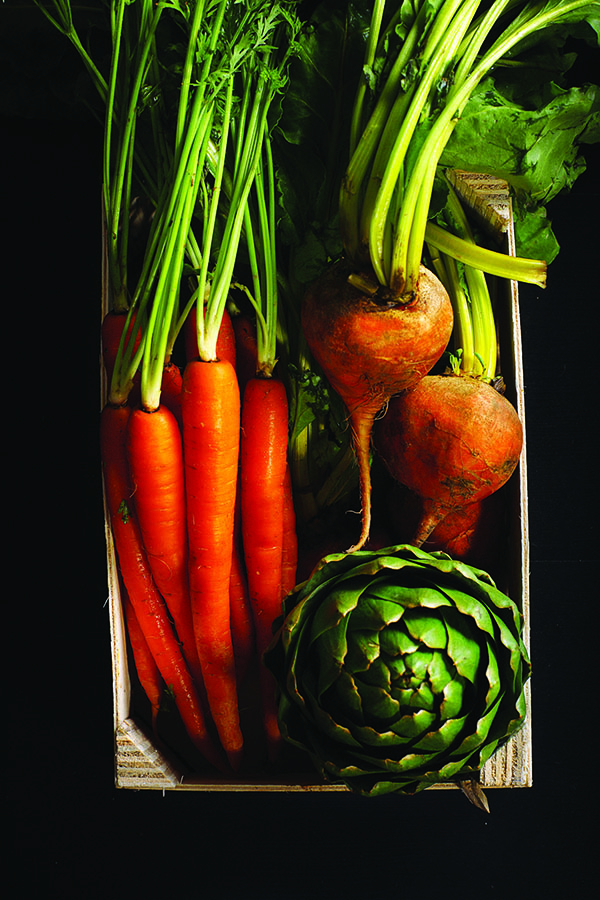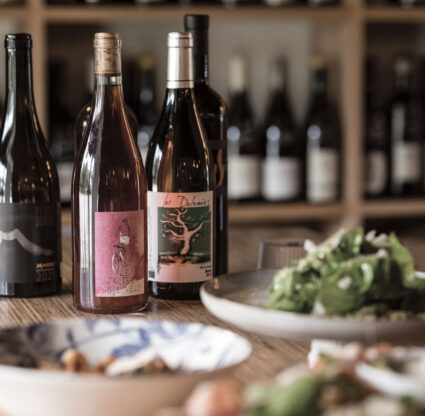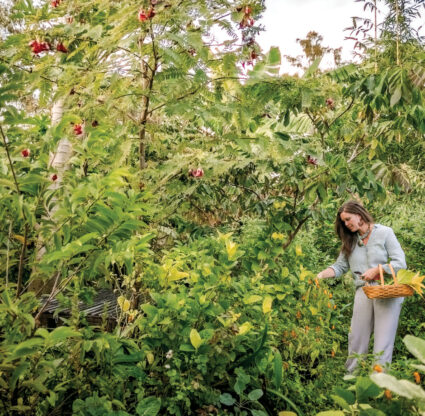On Saturday morning in downtown Naples, the past and the future our idea of food come together. At the Third Street Farmers Market, locals know the merchants by name shop alongside tourists hungry for something green and fresh in the middle of the gray winter back home. They stroll the long row of stalls offering crisp produce and artisanal baked breads and pies. Behind the mounds of arugula, escarole, turnips and leaf lettuce is likely to be the farmer who just the day before picked what he or she now offers up.
Some of this produce will end up a few blocks away on Fifth Avenue South, in trendy restaurants that tout their farm-to-table approach to cuisine. Some will wind up in the sleek kitchens of health-aware and increasingly food-savvy home cooks, for whom fresh, locally grown ingredients are as virtuous as a 10-mile morning jog.
Some food industry veterans wonder if the current focus on fresh and local isn’t just another trend in the fad-prone culinary world. But many online dining guides offer farm-to-table as a category of cuisine like French or vegetarian. And many of the world-renowned restaurants and chefs who pioneered the movement have been prominent for decades.
One brisk December Saturday, Nick Batty, whose six-acre Inyoni Farms is USDA-certified organic and produces 50 different varieties of vegetables, herbs, flowers and fruit in Northern Golden Gate Estates, bagged up red kale and watermelon radishes at the farmers market. “I’m just a farmer,” Batty says. “I’m not sure what (farm-to-table) means exactly. But I know it’s a growing trend, and I think it’s a great idea to promote good quality food.”
Ten years ago, when Batty was starting his farm on a 10-foot-by-10- foot plot, there were only a handful of growers in what he describes as “niche” farming. It’s still a risky proposition, starting a farm operation from scratch, but every year there are more people doing just that.
“I don’t think of it as competition,” Batty says. “My belief is that we need a lot of farmers. That’s what the country was founded on.”
Many motivations contribute to the local food trend: marketing niche, political statement, economic development, world view or simply a desire for better-tasting food. Regardless of motivation, at the heart of the concept lie some common values: slow, not fast; local rather than global; organic instead of processed; sustainable over disposable; and above all fresh.
Those values make up a kind of mission statement for The Sandy Butler Market and Shoals Restaurant & Wine Bar on San Carlos Boulevard near Fort Myers Beach. The gleaming market offers pickles, jams and jellies, canned goods and fresh produce and citrus grown on a 60-acre farm in Alva owned and operated by Tom and Maggie Sholls, whose family also owns the market and restaurant. In addition to a full menu of dishes featuring farm-grown produce, Shoals Chef Michael Ragusa offers a rotating tapas menu that focuses on whatever ingredients are in season, zucchini one month, tomatoes another, followed by eggplant or squash.
It’s a challenging way of cooking, but also rewarding, Ragusa says. “It’s incomparable. It’s controlled because you know where things are coming from. Sometimes with food every other year it’s a different trend. But the awareness people have for food these days is unbelievable.”
Farm-to-table is actually nothing new, Ragusa says. In Europe, cooks have always made dinner with whatever happens to be fresh and on hand. To that end, Chef Patrick Fevrier, whose Escargot 41 in Naples features classic French fare, uses seasonably fresh vegetables and more than 130 different fresh herbs from his five acre garden. In his native France, fresh herbs and produce are abundant. Here, the backyard garden is a necessity.
“Basically, we try to use whatever we have at the time,” Fevrier says. “The only way to have the things you need is to grow it. I think it’s a good idea, and people like it when you do something fresh.”
A hundred years ago any alternative to what is now called variously the local food, farm-to-table, locavore, or community farming would have been considered absurd. At the turn of the 20th century, back when one in three Americans lived and worked on farms, most of the food Americans ate was grown or raised within 50 miles.
Now, about 2 percent of the population lives on farms and only half of those claim that farming is their sole occupation. But when Americans left the farm for jobs in cities, they also left behind the food they used to grow and eat. By the turn of the 21st century, food production was vastly more centralized, global and far away. Whatever we bought at supermarkets or ordered in restaurants usually arrived over great distance and a long time removed from the places it had grown, grazed or swum.
Then about 10 years ago, a growing number of chefs and shoppers began thinking and talking about the political, environmental, economic, and health implications of our far-flung food distribution process. Centered significantly on the U.S. West Coast, organized efforts to encourage consumers to buy, cook and eat products from within a 100-mile radius, or the local “foodshed,” a term coined by a group of a San Francisco activists who called themselves “locavores.”
Such activists were inspired by pioneering restaurateurs like Alice Waters, whose renowned Chez Panisse in Berkeley, since 1971 has based its culinary philosophy on the central idea, according to its website, that the best-tasting food is organically and locally grown and harvested in ways that are ecologically sound by people who are taking care of the land for future generations.”
“When I first started the restaurant, I wasn’t looking for organic, local food,” Waters said recently in a television interview. “I understood that the flavor comes from the people who were planting the right varietals in the right place, and that they are taking care of it, and then they’re picking it when it’s ripe and then they’re bringing it to me.”
These days, as Stanford University- trained economist Michael Shuman points out, “Anyone who walks through an American city, suburb, or town will find at least one restaurant, supermarket, or farmers market advertising its connection to local food.”
Just three years after the San Francisco group first used the word “locavore” in 2007 it was cited by the Oxford English Dictionary as one of its important new “words of the year.” In May 2007, Time magazine’s cover urged to “Forget Organic, Eat Local.” A national best-selling book that same year, Animal Vegetable Miracle, described the experience of author Barbara Kingsolver and her family embracing a 100-mile diet.
Economist Shuman also points out that Slow Food International, whose vice president is Alice Waters, has more than 100,000 members in 132 countries.
In King County, Wash., Seattle-based restaurants keen on the farm-to-table virtues buy $30 million worth of ingredients from local farmers, according to Entrepreneur magazine. Some restaurants during the summer months get up to 90 percent of their ingredients locally. But locally sourced fare isn’t only a Seattle phenomenon nor one specific to the West Coast or blue states or affluent pockets of America. Entrepreneur points out that farm-to-table is big business almost everywhere, even Cleveland—named by Men’s Fitness magazine in 2007 as the junk-food capital of America. Whole Foods Market opened 183 stores across the country before it opened one in Cleveland. Yet even there, local sources of food thrive.
Two years ago, Shuman was commissioned to study the economics of the local food movement in Cleveland. After months of research, he concluded that if the demand for local food grew by 25 percent in the area, it would create more than 27,000 new jobs, enough to put back to work one in eight unemployed workers in the region. Each year the local economy would gain $4.2 billion in added output, $1.5 billion in value-added activities, $868 million in new wages and $126 million in new state and local tax revenues.
Since then, Shuman has been speaking across the country, including recently at the Florida Small Farms conference at the University of Florida, about ways to shift investment from Wall Street to community businesses and farms.
“This has become the hot thing that I think every small farmer and every small business person now needs to be paying attention to,” Shuman says. “It’s a trend for consumers, it’s a trend for government programs and also a trend that’s animating critics of local food. ”
In Southwest Florida, the farm-to- table movement flourishes. In addition to the market on Third Street, in Collier Country there are farmers markets on Marco Island, the Collier County Fair Grounds, and Immokalee, as well as the Naples Green Market at Golden Gate Parkway and Goodlette Road. In Lee County markets operate regularly downtown and Lakes Park in Fort Myers, Estero, Pine Island, Bonita Springs, Cape Coral and Sanibel Island.
The region also supports a number of sophisticated organic farm operations, including Worden Farm in Punta Gorda and Oakes Farm in Collier County.
Frank Oakes began organic farming in 1989 after growing up in a farm family in Fort Myers. He started Oakes Farm in East Collier County because he had grown dissatisfied with conventional farming and its ill effects on consumers’ health. In 2007 he opened Food and Thought, a marketplace in the Gateway of Naples plaza on U.S. 41 and Golden Gate Parkway that sells nothing that isn’t organically grown. Oakes describes himself as “militantly organic.” Most of his wares are grown on his farm, and he refuses to sell any product that has not been certified organic by the USDA or a third-party certification organization.
Worden Farm is an organic family farm 11 miles east of Punta Gorda. Since 2003, on their 85 acres, Chris and Eva Worden—both Ph.D.s— have grown more than 50 varieties of vegetables, fruits, herbs and flowers, all USDA-certified organic. The couple uses sustainable, ecological techniques designed to conserve resources and protect soil and water resources, wildlife and human health.
In addition to selling produce in farmers markets from Tampa to Naples, the Wordens operate a farm membership program in which participants pay $400 to $600 for 20 weekly boxes of farm fresh produce.
“It isn’t just about filling the stomach,” Eva Worden says. “It’s also about having a personal relationship with the people who grow the food.”
Are Organic Foods Really More Nutritious?
Want to start an argument?
Mention to a devotee of organic foods three little words: The Stanford Study. Researchers from the Stanford University School of Medicine drew worldwide attention—much of it angry criticism—when they concluded that there was no strong scientific evidence “that organic foods are significantly more nutritious than conventional foods.”
Published in the Sept. 4 issue of Annals of Internal Medicine, the study’s findings were based on a review of previous research, including 23 studies of people consuming organic and conventional diets and 223 studies of nutrients and contamination in foods
Organic products have no more vitamins than conventional food, the study found, and the only nutrient significantly higher in organics is phosphorus, which is insignificant, the researchers says, because few people have phosphorous deficiency. The study also found that organic milk has no more protein or fat content than conventional milk, though there is limited evidence that organic milk has significantly higher levels of omega-3 fatty acids.
The researchers could find no single organic fruit or vegetable that is consistently a healthier choice than conventional varieties.
“There isn’t much difference between organic and conventional foods, if you’re an adult and making a decision based solely on your health,” says the study’s author, Dr. Dena Bravata, on the Stanford School of Medicine website.
Critics of the study emerged immediately. They claimed that Stanford researchers’ conclusions were misleading because the study focused only on the nutritional comparison of organic and conventional foods and not on the effects of pesticides or any environmental impact of conventional farming.
Though the Stanford School of Medicine claimed the study received no external funding, bloggers everywhere raised suspicions that the study was influenced by donations to the university from Cargill, the conventional agriculture conglomerate.
Organic boosters dissected the Stanford researchers’ methods, down to misspellings. They pointed to a similar study published a year earlier by researchers at Newcastle University in England which found that organic produce, had more vitamin C and more of the naturally produced plant chemicals that protect people against cancer and heart disease.
One of the most outspoken critics of the study was Charles Benbrook, chief scientist at The Organic Center in Oregon, who published a critique of the research. “The Stanford team is a bunch of doctors and clinicians, and they took on a project completely outside their training and experience,” Benbrook told the Huffington Post.
“Unfortunately, their study doesn’t shed any light on the subject—just a lot of smoke.”
The Stanford researchers claim their aim was not to discourage people from buying organic food, but to educate them about their choices. “If you look beyond health effects, there are plenty of other reasons to buy organic instead of conventional,” Bravata says. Among those are conventional farming’s effects on the environment and animal welfare.
According to the Organic Trade Association, the American organic produce market grew 12 percent in 2011, to $12.4 billion, compared with 2010. The Stanford study isn’t likely to stop the organic movement, says Punta Gorda organic farmer Eva Worden.
Worden and her husband Chris run an 85-acre organic farm and both have Ph.D.s. Hers is in ecosystems management from Yale. “The nutritional value of food is something very difficult to prove analytically,” she says. “Plant nutrients are quite volatile.” Besides, says Worden, there are many other reasons than nutrition for eating organic food. Organics are far less exposed to chemicals, she says. And conventional farms contribute potentially harmful substances not only to the people who grow the food and those who eat it, but also to the drinking water supply for everyone.
There’s also a philosophical quality to locally grown organic food that’s harder to measure. “People today are looking for a connection to the people who grow their food and the earth they grow it in,” Worden says. “Everyone has to eat, but just having a friendly relationship to the farmer lends more value to the process.”
—KA
The Raw Milk Controversy
Fresh, local, and unprocessed are bedrock values to the farm-to-table movement. But for some health authorities warn there are—or should be—limits to those principles.
Milk, for example, if not heated to a temperature high enough to kill foodborne contaminants, can contain potentially lethal bacteria. Selling unpasteurized milk, also called raw milk, is illegal in 18 states, including Florida.
But raw milk is readily available in Southwest Florida. Food and Thought organic grocery in the Gateway Plaza off U.S. 41 in Naples sells unpasteurized milk in containers labeled “For Pet Consumption Only.”
And Camilla Eastern European Food Market, at 4947 Tamiami Trail N. in Naples, sells 60 to 80 gallons of raw milk every two weeks, along with raw yogurt, cream and butter, says owner Melissa Kashkin.
“Most of our customers for raw milk are very health conscious,” Kashkin says. “They come in specifically for that and usually don’t buy anything else.”
Its purveyors claim not only is raw milk not dangerous, it has nutritional qualities that are lost to pasteurization.
Naples chef Don Splain, who maintains the website, keepmilkraw.org, claims, “Clean raw milk from pastured cows is a complete and properly balanced food. You could live on it exclusively if you had to.”
Splain’s site touts dozens of health benefits of raw milk, including aids to the immune system, natural chemicals that may counteract lactose-intolerance and healthy bacteria and enzymes that promote healthy digestion.
Raw milk enthusiasts like Splain claim they are as likely to contract a foodborne illness from contaminated spinach or ground beef. But there is a key difference, says Dr. Richard Raymond, former U.S. Agriculture Department undersecretary for Food Safety. Other foods don’t have a sure-fire method of killing dangerous bacteria, and milk does. Pasteurization has saved thousands of infants’ lives, Raymond says, and despite resistance to the process when it was introduced in the 1920s, it is now accepted and demanded by 97 percent of Americans.
The Centers for Disease Control reports that between 1993 and 2006, 239 people were sent to the hospital as a result of contaminated milk and three of those cases were fatal. Almost 85 percent of those cases, 202, were caused by raw milk, which also led to two of the three deaths. This despite raw milk accounting for only 1 percent of the total milk consumed in the U.S.
The CDC also reports that the raw milk cases were more serious than those hospitalizations from pasteurized milk because the raw milk cases involved bacterial infections, such as E. coli, which can cause kidney failure and even death, while processed milk illnesses involved relatively mild viral infections and food-borne toxins mostly caused by improper storage or food preparation.
Perhaps most troubling, according to the CDC, 60 percent of the people sickened by raw milk were younger than 20, compared to 23 percent of the cases involving pasteurized milk. The American Academy of Pediatrics advises parents against feeding children raw milk.
Dr. Raymond goes further in his advocacy of pasteurization: “To not use this technology to our advantage to protect our children from unnecessary suffering or death should be considered criminal.”





